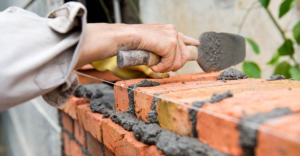Brick masons construct walls, walkways and other structures from bricks and other types of masonry. They follow detailed building instructions and apply a variety of construction techniques.
Masons use mortar, a mixture of cement, sand and water, to hold the bricks together. They mix the mortar to a precise consistency. Contact Brick Masons Charleston, SC now!

Brick masons use their masonry skills to build walls, floors, partitions, chimneys and other structures that are aesthetically pleasing and structurally sound. They work with bricks, but also with concrete blocks and other construction materials depending on the project requirements.
Masonry is a physically demanding profession, and brick masons must be physically strong to perform their duties. This is because the job involves heavy lifting and extended periods of standing or crouching. Most masons spend their days on construction sites and are exposed to various environmental hazards, such as dirt, dust, falling debris and the possibility of getting injured by tools or other employees. They must be able to protect themselves by wearing steel-toed boots, safety glasses and helmets.
In addition to physical strength, brick masons must be able to follow blueprints and design plans for the structure they are building or repairing. They also need to be able to calculate the amount of materials they will need for the project, such as the number of bricks or mortar. Masons must have good attention to detail so they can ensure that the finished product matches the original design, both aesthetically and structurally.
Many brick masons, also known as bricklayers, complete a vocational training program in a trade school or community college to learn the necessary skills. After completing their education, they typically gain hands-on experience in the field by working as an apprentice under a master brickmason. Masons can also obtain certification in their field to increase their professional credibility and improve job opportunities.
While some brick masons are self-employed contractors, most work for large masonry or construction companies. The wages for this career vary according to the location and demand for masonry services. Brick masons who are members of a union often get well-rounded training in all aspects of masonry and are able to progress quickly into supervisory roles.
The Department of Interior (DOI) uses masonry skills to help maintain its many buildings and facilities. For example, the agency maintains miles of walkways and 40,000 historic houses, forts and other structures. The DOI relies on brick masons to lay and repair the structures that make up these historic areas, and they are often called upon for a variety of restoration and preservation projects.
Hand-Eye Coordination and Dexterity
Brick masons must have good hand-eye coordination and dexterity to work with the materials and tools of their trade. This is especially true when they are laying bricks and other materials in tight spaces, such as around corners or windows. Having these skills helps them create aesthetically pleasing brick structures and ensures that they follow the specifications of their project’s blueprints correctly.
Masons often mix and apply mortar, which is a cement, sand, and water mixture that holds bricks together. Mixing mortar requires precision, as the masons must carefully measure and combine the correct proportions of each material. They also must be able to apply the mortar evenly and clean up any excess before it hardens. The ability to do these tasks without tiring is an important attribute for masonry workers because they spend most of their time on the job site.
Most brick masons work in construction sites, so they must be comfortable working outdoors and on ladders or scaffolding. They must also be able to lift heavy building materials and shape cement blocks. This can be physically demanding, especially for masons who are working overtime to meet construction deadlines. In order to stay safe, masons should wear steel-toed boots, safety glasses, and other protective gear.
Masonry is a hands-on career that requires training in technical programs at trade schools or community colleges, and on-the-job experience as an apprentice with a master mason. In addition to learning how to operate the tools of their trade, students in a masonry program learn how to read and interpret blueprints, understand building codes, and know industry safety requirements.
Masons must be able to communicate well with other members of their construction teams and general contractors, as they often work on large projects that require collaboration. They must be able to relay instructions clearly and answer questions effectively, so that the other members of their team can complete their tasks on schedule. They also must be able to collaborate with engineers and architects on projects that are more complex, such as bridges or high-rise buildings.
Communication Skills
Masons need to be able to communicate clearly with others, such as other brick masons, construction workers and architects. This ensures that all parties are on the same page and that projects proceed according to plan. It also allows for efficient teamwork, which leads to the best results for a building project. Masons may also need to provide verbal or written instructions for other crew members, especially on the specific materials and processes involved in a particular job.
Masonry requires a high level of precision and attention to detail. In addition, it often involves working with a variety of tools and equipment. Masons need to be able to operate machinery such as power saws and forklifts, and use digital measuring devices, hammers, chisels and trowels. Masons also need to be able to follow detailed construction instructions, such as those provided by architects and engineers.
Brick masons need to have strong problem-solving skills, as they frequently encounter challenges while on the job. These can include uneven surfaces, changes in design and weather conditions that affect the quality of the mortar. Masons who can think on their feet and come up with creative solutions are more likely to complete construction on time and within budget.
Depending on their area of expertise, brick masons may choose to focus on residential, commercial or industrial projects. For example, some masons specialize in restoring historic structures, such as the renowned Casa Loma in Toronto. These masons require a high level of knowledge about traditional brickwork techniques and materials, which can be used to preserve the historical integrity of older buildings.
Other masons choose to focus on new construction. This may involve building large scale public projects, such as skyscrapers or office buildings. These masons need to have excellent organizational skills and be able to meet strict deadlines. Masons in this field need to be able to accurately measure dimensions and calculate the amounts of materials required for a given project.
Those who have advanced skills in their field may choose to become masonry contractors, where they supervise other brick masons on construction sites. They may also choose to pursue a career in teaching, by instructing students on the art of brick masonry.
Mathematical Skills
Brick masons need to be good at math in order to interpret blueprints and construction plans accurately. They also use math skills when measuring and calculating the dimensions of materials that they need to lay and mix. This ensures that they have enough material to complete their work and avoids excess waste.
Brick masonry is a skilled trade, and bricklayers are highly sought after in the construction industry for their expertise. They are able to build durable and visually appealing structures that enhance buildings and other structures in residential, commercial and industrial settings. In addition to their hardworking attitude and superior craftsmanship, brick masons are able to work well as part of a team and have the ability to problem-solve.
Many brick masons learn their trade through apprenticeship programs, where they work alongside experienced professionals. They may also enroll in a brick masonry program at a vocational school or community college to gain more formal education in the field. Some also pursue certification from the National Center for Construction Education and Research or the Brick Industry Association, which can help them find employment.
Masonry is a demanding career that requires physical stamina, dexterity and an attention to detail. It is important for brick masons to be able to sketch out constructions and designs before they start building them, and they must be able to interpret blueprints and construction drawings correctly. This attention to detail is especially critical when working with mortar, a mixture of cement, sand and water that holds bricks together. Masons must be able to mix the mortar to the right consistency, and they must also apply it evenly across the surface of each brick to ensure that it adheres properly.
As brick masons gain experience and develop their craft, they may advance to supervisory roles or become responsible for overseeing larger construction projects. This can greatly increase their earning potential, as these positions typically come with a higher pay scale.


